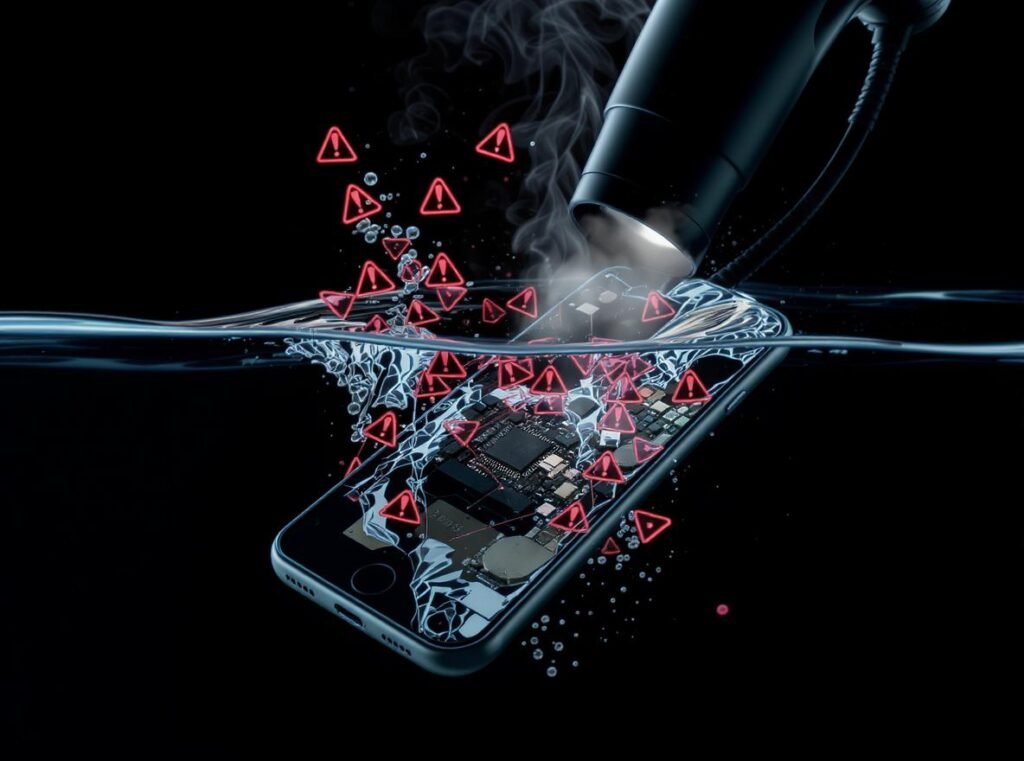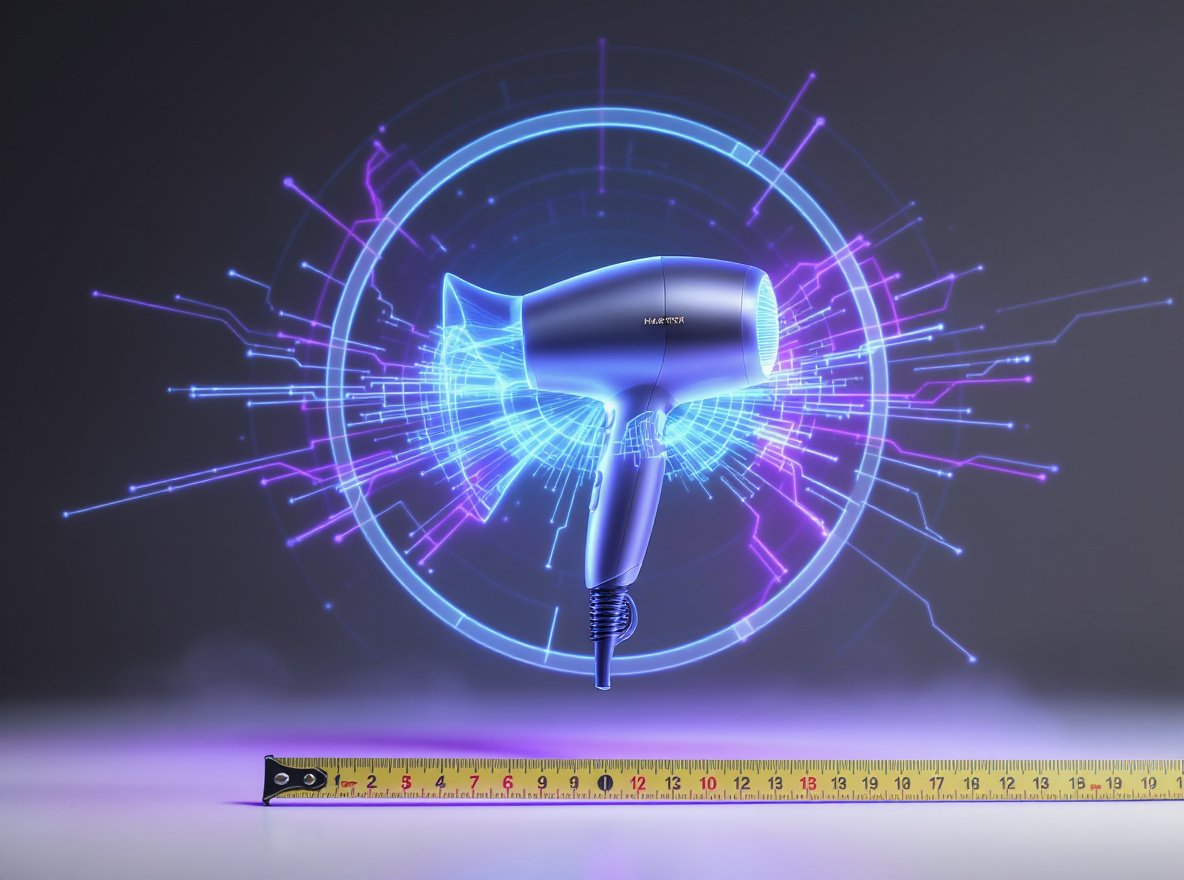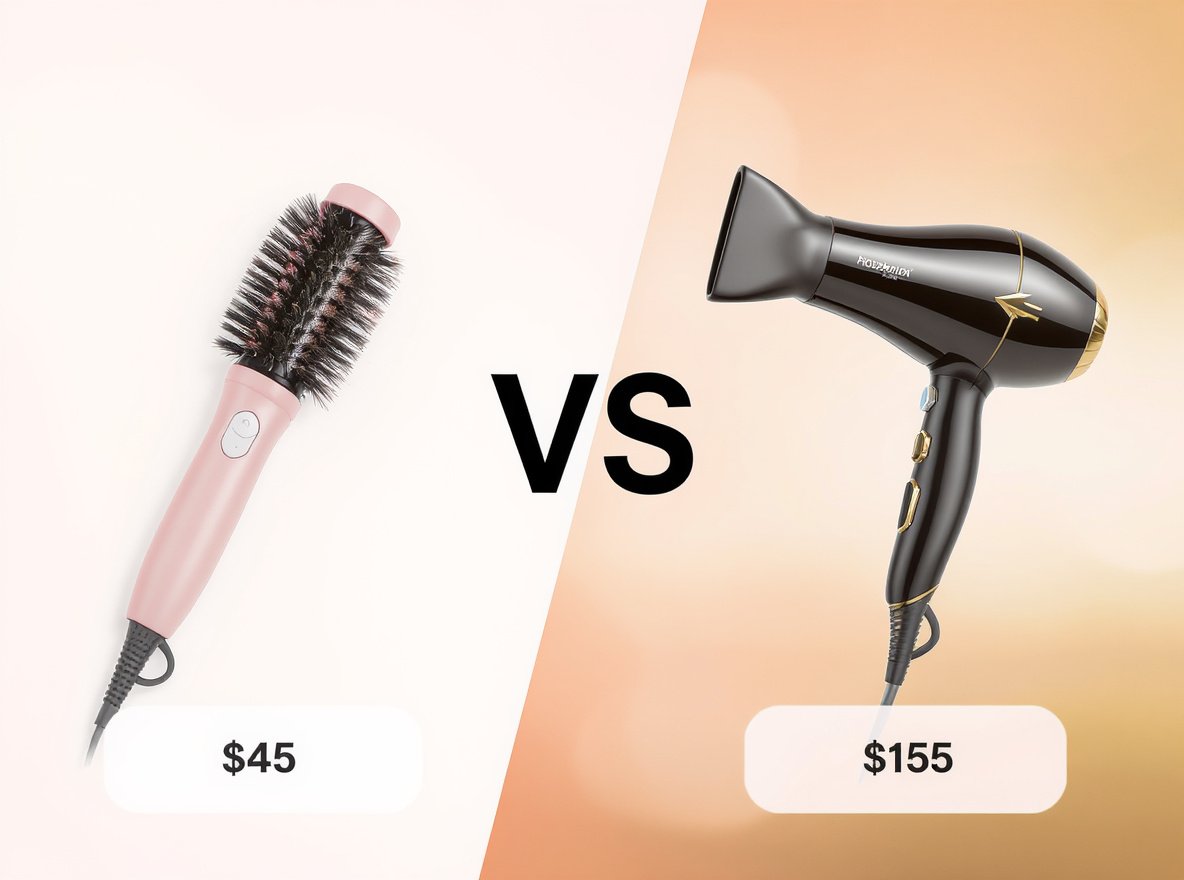You dropped your phone in water and desperately need it back to life. The hair dryer seems like the perfect solution to quickly evaporate that moisture. But this common impulse could destroy your device permanently.
Using a hair dryer on a wet phone is strongly discouraged by experts and can cause irreparable damage. The intense heat can push water deeper into internal components, overheat sensitive circuits, and worsen corrosion. Professional repair services and phone manufacturers universally advise against this method.
Let’s explore the science behind why hair dryers fail as phone rescue tools and discover safer alternatives.
Table of Contents
ToggleCan Hair Dryers Actually Remove Water from Phones?
Understanding the physics behind water damage helps explain why hair dryers create more problems than solutions.
Hair dryers can only dry exterior surfaces of phones but are completely ineffective at removing moisture from internal components. The heat and airflow from hair dryers don’t penetrate deeply enough to reach water trapped inside the device, and the process often causes more harm than good.
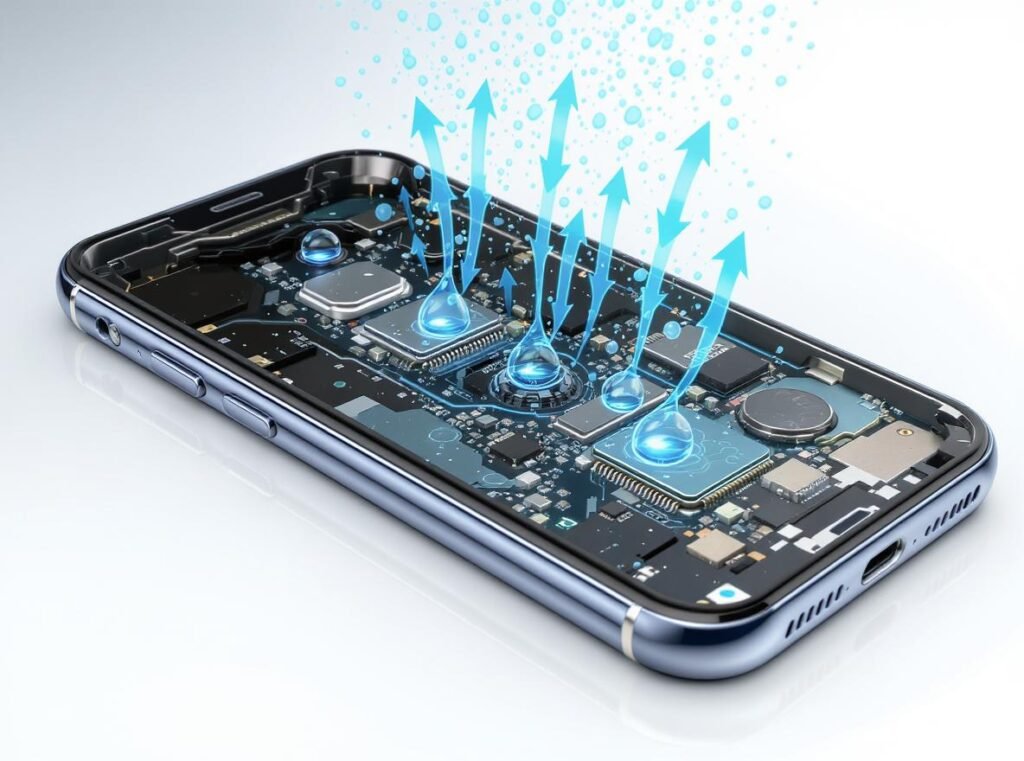
When water enters your phone, it doesn’t just sit on the surface. The moisture seeps through ports, speakers, and microscopic gaps to reach sensitive internal components. Hair dryers excel at surface drying but fail where it matters most—inside your device.
The fundamental problem lies in accessibility. Internal phone components are sealed within multiple layers of protection, making them inaccessible to external airflow. Even professional-grade hair dryers cannot generate enough precision to target these critical areas without causing collateral damage.
Modern smartphones contain intricate pathways where water can hide:
- Between LCD layers and digitizers
- Around circuit board connections
- Inside speaker and microphone chambers
- Within battery compartments and charging ports
Surface drying creates a false sense of security while internal moisture continues its destructive work.
Why Do Hair Dryers Damage Wet Phones?
The misconception that hair dryers help stems from their effectiveness on external surfaces, but phones require different treatment entirely.
Hair dryers cause multiple types of damage including heat damage to sensitive components like batteries and circuit boards, thermal shock from sudden temperature changes, increased condensation and corrosion inside the device, and permanent damage to rubber seals and adhesives that protect against future water exposure.
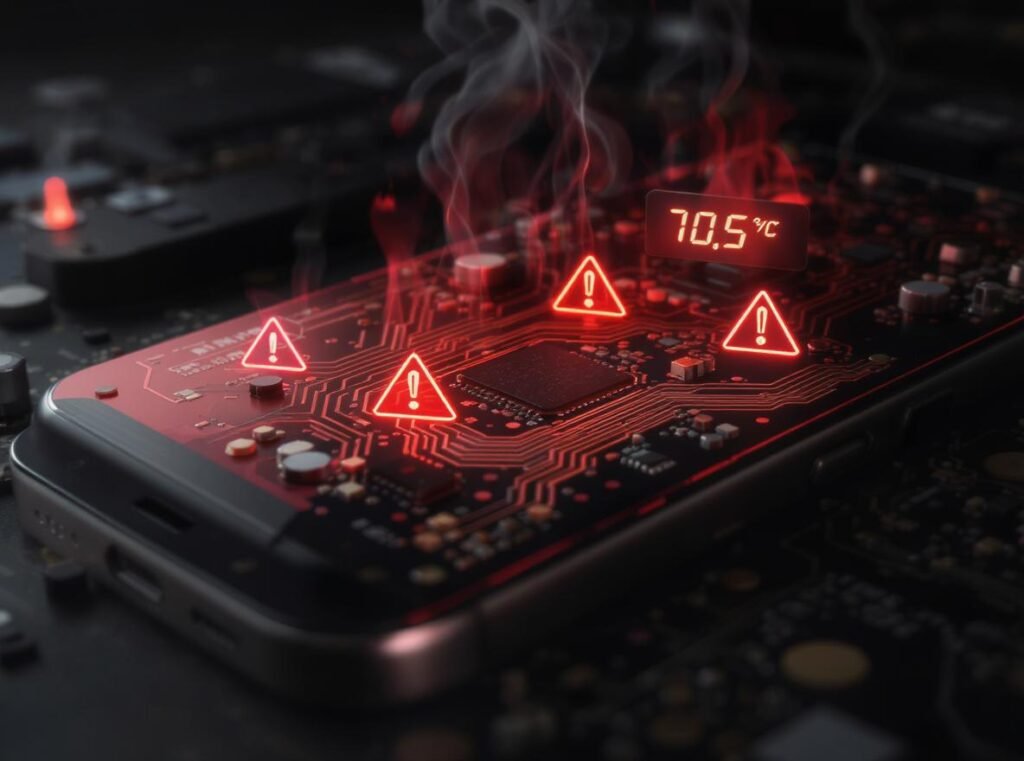
The damage occurs through several mechanisms:
Heat Damage to Critical Components:
Hair dryers generate temperatures between 120-200°F (49-93°C), which exceeds safe operating limits for smartphone components. Batteries are particularly vulnerable, with exposure potentially causing swelling, leakage, or even explosion.
| Component | Safe Temperature | Hair Dryer Risk |
|---|---|---|
| Lithium Battery | 32-113°F (0-45°C) | Thermal runaway, swelling |
| LCD Screen | 14-140°F (-10-60°C) | Pixel damage, backlight failure |
| Circuit Boards | 32-158°F (0-70°C) | Solder joint failure, component damage |
Thermal Shock Effects:
Rapid heating after water exposure creates stress on phone components. The sudden temperature change can cause materials to expand at different rates, leading to cracked solder joints, loose connections, or warped internal structures.
Accelerated Corrosion:
Heat increases the rate of chemical reactions, including corrosion. What might take weeks to develop naturally happens in hours when exposed to hair dryer temperatures. This explains why phones sometimes work initially but fail days later.
Seal and Adhesive Degradation:
Modern phones rely on precise rubber seals and specialized adhesives for water resistance. High temperatures can soften, warp, or chemically break down these materials, permanently compromising the device’s protection against future moisture exposure.
What Happens When You Use a Hair Dryer on a Wet Phone?
Real-world scenarios demonstrate the progressive damage that hair dryer treatment causes to water-exposed devices.
Using a hair dryer on a wet phone typically results in surface drying only while leaving internal water trapped, heat damage to sensitive components, and long-term corrosion issues. Any remaining moisture combined with heat damage often renders the phone completely unusable within days or weeks.
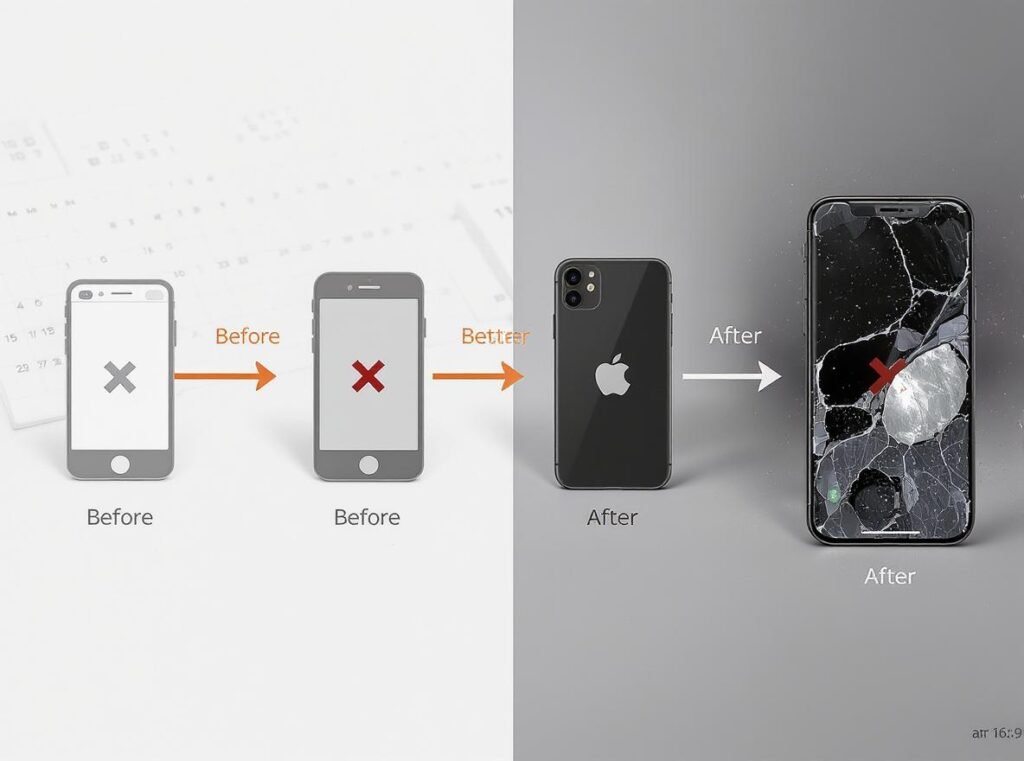
The damage timeline follows a predictable pattern:
Immediate Effects (0-2 hours):
- Surface moisture evaporates, creating false confidence
- Internal components begin experiencing thermal stress
- Water gets pushed deeper into previously protected areas
- Adhesives start softening from heat exposure
Short-term Consequences (2-48 hours):
- Battery chemistry becomes unstable from heat exposure
- Corrosion accelerates on exposed metal contacts
- Screen functionality may become intermittent
- Charging port connections start failing
Long-term Failure (1-4 weeks):
- Complete battery failure or dangerous swelling
- Permanent screen damage or total blackout
- Motherboard corrosion spreads to critical circuits
- Device becomes completely non-functional
Professional repair technicians report that phones treated with hair dryers often arrive in worse condition than those left to air dry naturally. The apparent initial success masks ongoing internal damage that continues progressing even after the phone appears functional.
Water damage isn’t always immediately visible, and the hair dryer’s heat accelerates every destructive process happening inside your device.
What Are Safe Alternatives to Hair Dryers for Wet Phones?
Professional repair services and manufacturers recommend proven methods that address both surface and internal moisture without introducing additional damage.
The most effective approach combines immediate power shutdown, gentle exterior drying, component separation when possible, gravity-assisted drainage, and controlled moisture absorption using proper desiccants. This method addresses water comprehensively without heat damage or forced air pressure.
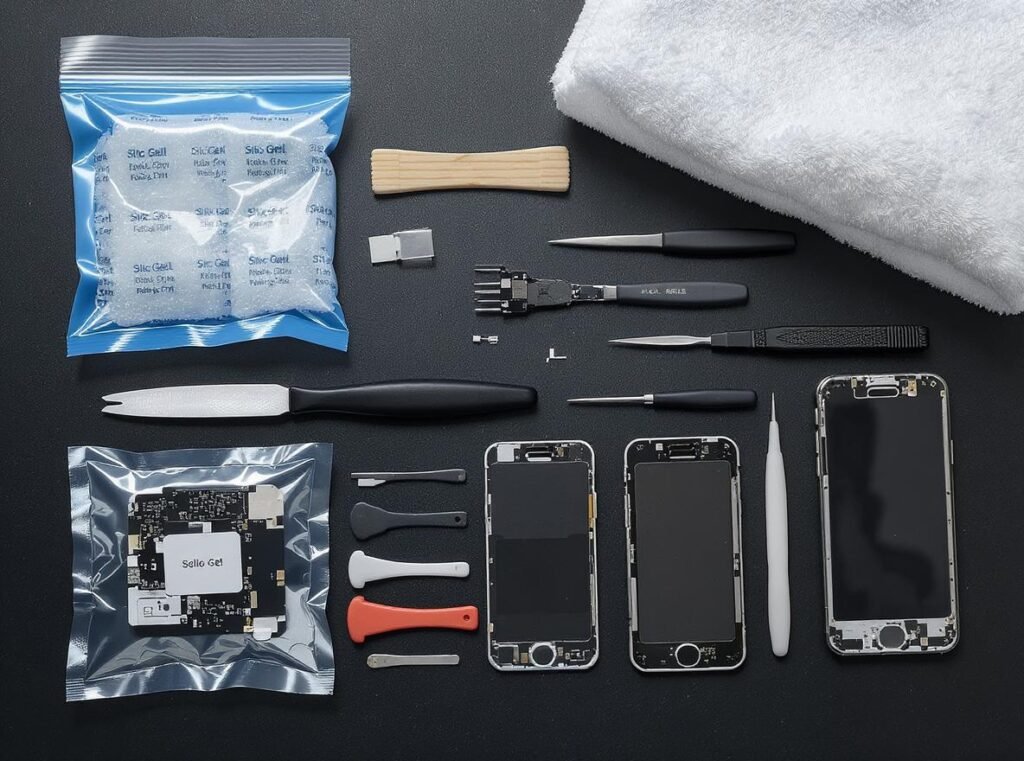
Follow this proven recovery process:
Emergency Response (First 5 minutes):
- Power off the device immediately—don’t test if it works
- Remove from water source as quickly as possible
- Don’t press buttons or attempt to charge the device
Proper Disassembly:
- Remove phone case, screen protector, and any accessories
- Extract SIM card and SD card if accessible
- For phones with removable batteries, separate battery and back housing
- Place all components on absorbent towels
Gravity-Assisted Drainage:
For iPhones and sealed devices, gently tap the phone with Lightning or USB-C port facing downward. This allows trapped liquid to flow out through the most accessible opening. Avoid vigorous shaking, which can spread water to previously dry areas.
Professional Drying Setup:
- Use silica gel packets (more effective than rice) in a sealed container
- Ensure good air circulation around the container
- Include all phone components separately
- Wait 24-48 hours minimum before attempting power-on
Desiccant Effectiveness Comparison:
| Drying Method | Moisture Absorption | Time Required | Success Rate |
|---|---|---|---|
| Silica Gel Packets | Excellent | 24-48 hours | 40-60% |
| Uncooked Rice | Moderate | 48-72 hours | 25-35% |
| Hair Dryer Treatment | Poor (surface only) | 2-4 hours | 15-25% |
| Professional Service | Excellent | 2-5 days | 70-85% |
How Do Professional Hair Dryers Compare for Phone Drying?
Businesses often wonder whether high-end professional hair dryers offer safer alternatives for device recovery, given their advanced features and better temperature control.
Professional hair dryers, despite superior temperature control and advanced features, still pose significant risks to water-damaged phones. No evidence suggests they’re safer or more effective than consumer models, and professional phone repair services never use hair dryers—they employ specialized equipment designed specifically for electronics recovery.
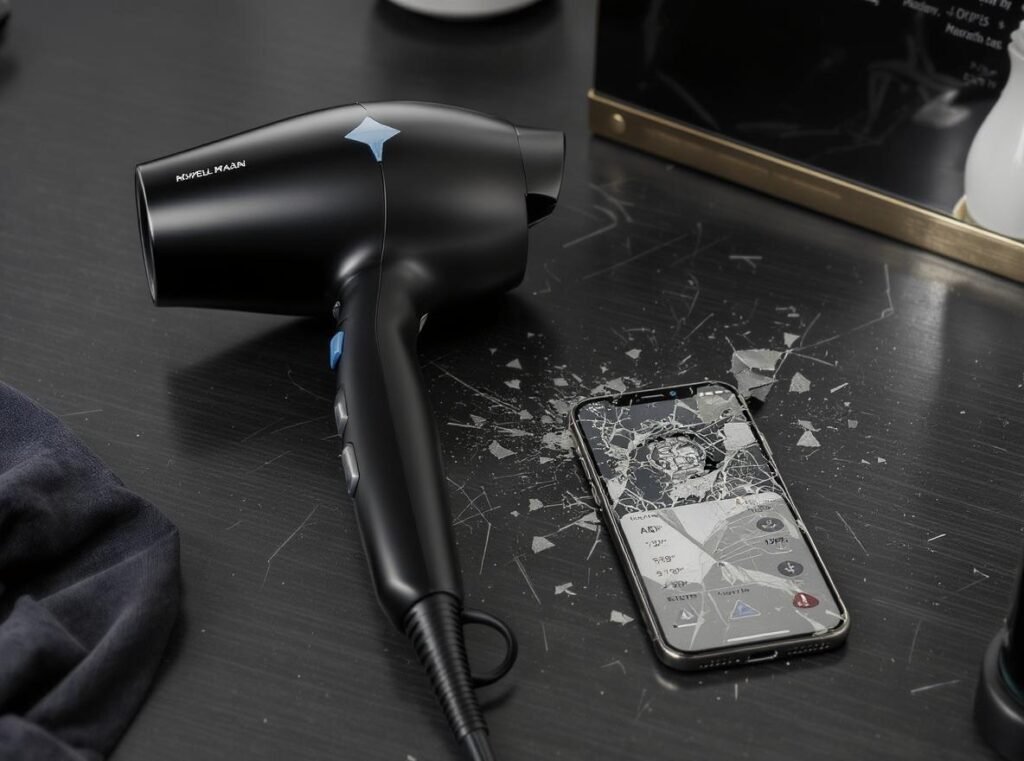
Professional salon-grade dryers typically feature:
Advanced Temperature Controls:
- Multiple heat settings with precise temperature regulation
- Cool shot buttons for instant temperature reduction
- Ceramic heating elements for even heat distribution
- Ionic technology for faster drying
Enhanced Airflow Management:
- Variable speed controls for gentler airflow
- Concentrated nozzle attachments for precision
- Reduced noise levels for professional environments
- Longer-lasting motors for extended use
However, these features don’t address the fundamental problems:
| Professional Feature | Hair Styling Benefit | Phone Recovery Risk |
|---|---|---|
| Ionic Technology | Reduces static, adds shine | Can interfere with electronic components |
| Ceramic Heating | Even heat distribution | Still exceeds safe phone temperatures |
| Cool Shot Function | Sets hair styles | Insufficient for thorough internal drying |
| Variable Speed Control | Styling versatility | Lower speeds still create harmful pressure |
Professional repair services use completely different equipment:
- Ultrasonic cleaning baths for component cleaning
- Controlled atmosphere drying chambers
- Isopropyl alcohol baths for corrosion prevention
- Specialized vacuum systems for moisture extraction
Even high-quality professional hair dryers like the Conason P1C High-Speed Hair Dryer, engineered for optimal salon performance and safety, aren’t designed for electronics recovery. These tools excel at their intended purpose—professional hair styling—but lack the precision control needed for delicate phone components.
For businesses in the hair dryer wholesale market, it’s crucial to educate customers about appropriate applications and discourage misuse that could damage both devices and brand reputation.
Can Cold Air from Hair Dryers Help Dry Phones?
Many people believe the cool air setting on hair dryers provides a safe compromise between effective drying and damage prevention.
Cold air from hair dryers offers minimal benefit and can still cause damage through forced air pressure. The cool setting typically operates at 70-80°F, which reduces thermal risks but still creates airflow that can blow water deeper into internal components, potentially causing more harm than passive drying methods.

The cool air approach addresses only thermal damage while ignoring other critical problems:
Reduced Risks:
- Eliminates thermal damage to heat-sensitive components
- Prevents accelerated corrosion from high temperatures
- Avoids adhesive breakdown and seal damage
- Reduces battery chemistry disruption
Remaining Dangers:
- Forced air pressure drives water into previously protected areas
- Inadequate moisture removal from internal spaces
- Potential damage to delicate internal components from air pressure
- False confidence leading to premature device activation
Professional repair experts report that even cool air treatment can worsen water damage by redistributing moisture. The forced airflow creates pressure differentials that push water through microscopic gaps and into areas that might have remained dry.
Better alternatives for gentle drying include:
- Natural air circulation using room fans positioned away from the device
- Desiccant-based moisture absorption in controlled environments
- Professional vacuum drying systems that remove rather than redistribute moisture
- Controlled temperature environments maintaining consistent room temperature
The key principle is patience over speed—effective water damage recovery requires time, not force.
What Should You Do Instead of Using a Hair Dryer?
The most successful phone recovery methods prioritize systematic moisture removal over quick fixes, addressing both immediate and long-term damage prevention.
Effective water damage recovery requires immediate power shutdown, gentle exterior drying, proper component separation, desiccant-based moisture absorption, and patience. This comprehensive approach addresses both surface and internal moisture while avoiding the additional damage vectors that hair dryers introduce.
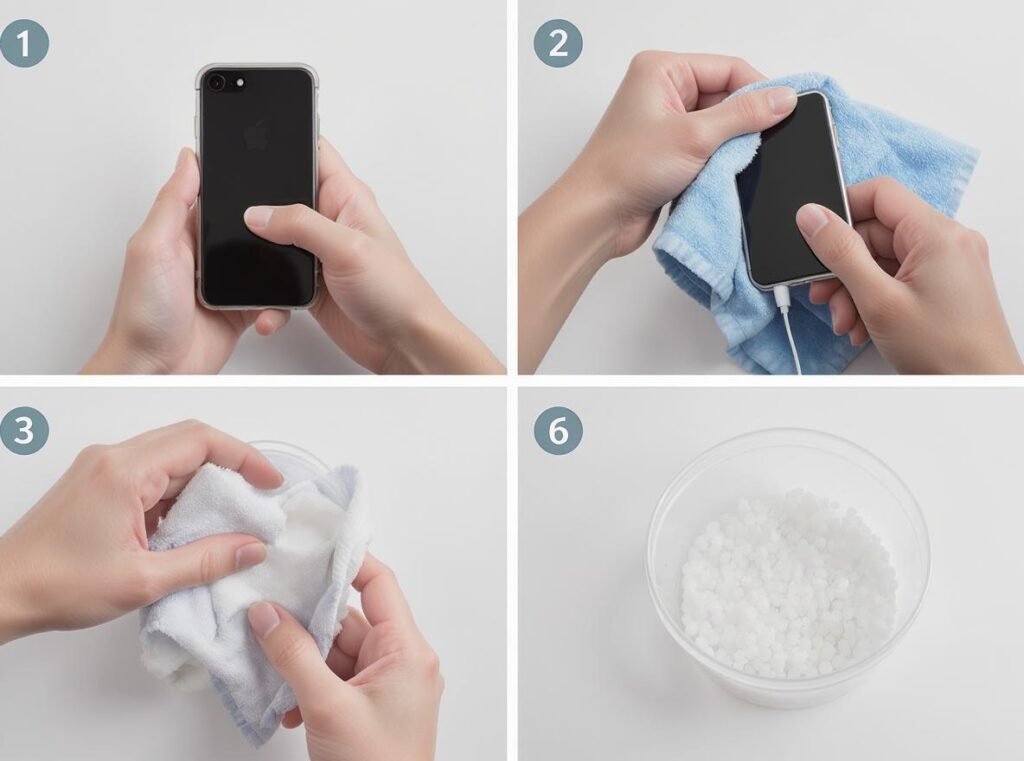
Complete Recovery Protocol:
Step 1: Emergency Shutdown
- Power off immediately without testing functionality
- Remove from water source within seconds if possible
- Resist the urge to press buttons or check for damage
Step 2: Initial Assessment and Disassembly
- Remove phone case, screen protector, and all accessories
- Extract SIM card, SD card, and any removable components
- For phones with removable batteries, separate battery and back housing immediately
- Document any visible damage with photos for insurance purposes
Step 3: Contamination Management
If your phone contacted chlorinated pool water, salt water, or soapy water, gently rinse with clean tap water to remove corrosive residues. This counterintuitive step prevents additional chemical damage from pool chemicals or salt crystals.
Step 4: Gentle Surface Drying
- Use absorbent cloth to pat (don’t wipe) exterior surfaces
- Avoid pushing water into ports or openings
- Pay special attention to speaker grilles and charging ports
- Replace absorbent materials frequently to prevent recontamination
Step 5: Gravity-Assisted Drainage
- Hold device with ports facing downward
- Gently tap to encourage liquid flow from internal spaces
- Avoid vigorous shaking that could spread water to dry areas
- Continue until no more liquid emerges
Step 6: Professional Desiccant Setup
- Use silica gel packets in sealed containers (more effective than rice)
- Ensure adequate desiccant quantity—approximately 1 packet per phone component
- Maintain good air circulation around sealed containers
- Place components separately to maximize surface area exposure
Step 7: Extended Drying Period
- Allow minimum 24-48 hours for complete moisture removal
- Resist testing device during this critical period
- Consider professional evaluation if device is business-critical
- Document timeline for insurance or warranty claims
Step 8: Cautious Reactivation
- Reassemble completely before attempting power-on
- Monitor for unusual behavior, excessive heating, or battery swelling
- Back up data immediately if device functions normally
- Seek professional evaluation if any abnormal symptoms appear
Are There Professional Services for Water-Damaged Phones?
Professional phone repair services offer specialized equipment, expertise, and success rates that far exceed DIY recovery methods, making them the preferred choice for valuable devices.
Professional phone repair services achieve 70-85% success rates using ultrasonic cleaning, controlled environment drying, component-level diagnostics, and specialized restoration techniques. These services provide comprehensive solutions including data recovery, component replacement, and warranty protection that DIY methods cannot match.
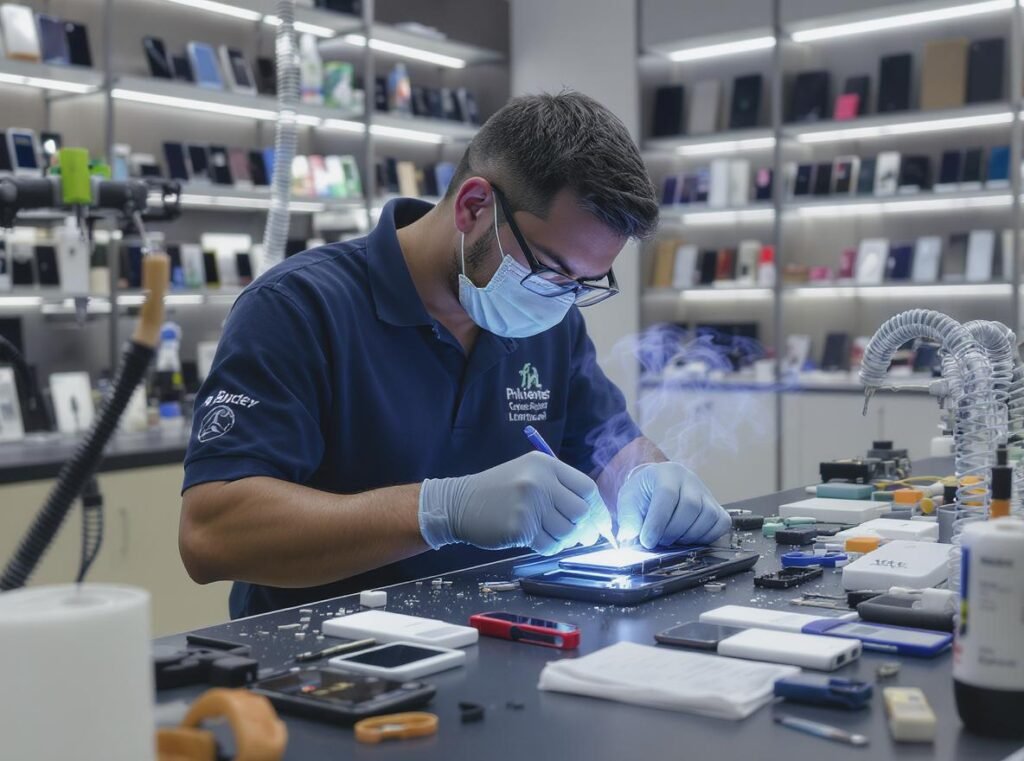
Professional water damage recovery includes:
Advanced Diagnostic Services:
- Complete device teardown and moisture assessment
- Component-by-component functionality testing
- Corrosion damage evaluation and mapping
- Data recovery feasibility analysis
- Detailed repair cost estimates
Specialized Equipment and Techniques:
- Ultrasonic cleaning baths remove corrosive residues
- Controlled atmosphere drying chambers eliminate moisture completely
- Isopropyl alcohol treatments prevent ongoing corrosion
- Component-level testing and replacement capabilities
- Clean room environments prevent contamination
Comprehensive Service Offerings:
| Service Type | Professional Capability | DIY Limitation |
|---|---|---|
| Internal Cleaning | Ultrasonic baths, specialized solvents | Surface cleaning only |
| Moisture Removal | Vacuum systems, controlled atmosphere | Passive drying methods |
| Component Testing | Individual circuit testing | Visual inspection only |
| Data Recovery | Specialized software and hardware | Limited access to data |
| Parts Replacement | OEM components, micro-soldering | No replacement capability |
Success Rate Comparison:
| Recovery Method | Success Rate | Typical Cost | Time Required |
|---|---|---|---|
| Hair Dryer Treatment | 15-25% | $0 | 2-4 hours |
| Rice/Silica Gel | 40-50% | $5-15 | 24-48 hours |
| Professional Service | 70-85% | $50-200 | 2-5 days |
| Device Replacement | 100% | $200-1000+ | Immediate |
Many professional services offer no-recovery, no-charge policies that eliminate financial risk while providing the highest probability of successful restoration. The investment often costs significantly less than device replacement, especially for newer smartphones with high replacement values.
When to Choose Professional Services:
- Device contains irreplaceable data or photos
- Phone value exceeds $300
- Business-critical device requiring immediate attention
- Previous DIY attempts have failed
- Device shows signs of severe corrosion or component damage
For businesses wholesale purchasing hair dryers, consider establishing partnerships with certified repair services. This relationship demonstrates product knowledge, provides genuine customer value, and creates additional revenue opportunities while reinforcing appropriate hair dryer usage.
Summary
Hair dryers cannot safely remove water from phones and typically cause more damage than they prevent. The combination of excessive heat and forced airflow pushes moisture deeper into sensitive components while accelerating corrosion processes that may not become apparent for days or weeks. Professional repair services and proper desiccant-based drying methods offer significantly higher success rates without introducing additional damage vectors. When electronic devices encounter water, patience and proper technique consistently outperform quick fixes and emergency measures.
Ready to explore professional-grade hair dryers for their intended purpose? Browse our complete collection of high-performance hair dryers at Conason Products or discover our flagship P1C High-Speed Hair Dryer engineered for professional salon applications. Contact our team for wholesale pricing and bulk orders that meet your business requirements.

